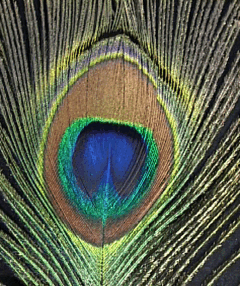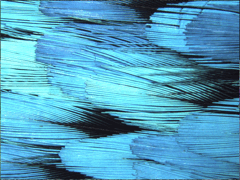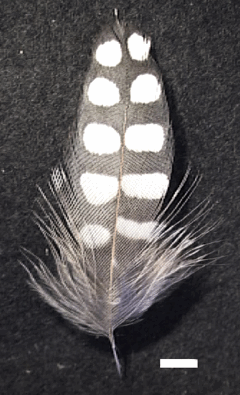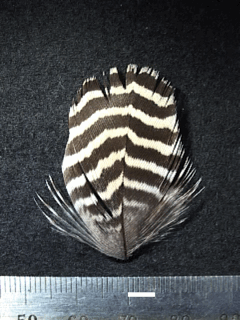Bird Genius
Air Date: Week of October 2, 2009

Pavo cristatus is the Peacock
Ornithologist Richard Prum studies everything to do with bird development, evolution, and behavior. He’s especially interested in the most festive part of the bird: its vibrant feathers. Prum was just awarded a MacArthur “genius grant” for his work. Host Jeff Young talks with the Yale professor about his unique approach to the field of ornithology.
Transcript
YOUNG: Some 46 million people in this country say they are birdwatchers. But not many watch birds quite the way Richard Prum does. Prum’s an ornithologist at Yale who looks closely—microscopically closely—at bird feathers. That’s revealed profound insight into just how birds got their amazing variety of colors. Dr. Prum’s work was recognized last month by the MacArthur Foundation—he received one of their prestigious awards, sometimes called the MacArthur genius grants. Dr. Prum, why feathers?
PRUM: Well, I have been a life-long bird watcher and bird nut, frankly. And through teaching ornithology over the years, I became increasingly interested in feathers, themselves. First, I just thought this is a fundamental aspect of avian biology that I ought to know about, and I found that there was surprisingly little modern literature on feathers and that there were great research opportunities, great unanswered questions. That is what led me into this sort of feather mania stage of my career.
YOUNG: And specifically, you’re studying feather colors, right?

Cotinga cayana is Spangled Cotinga from the Amazon
PRUM: We have studied just about everything about feathers that we can fit into time. In particular, we’ve been studying structural colors, which are colors that are made by interaction of light with the material of the feather, itself. These include blue jays, or bluebirds, or hummingbirds, and these are colors that, like the anti-fraud holograms on your credit cards, are the result of light bouncing off of a material object, in this case air bubbles or pigment granules in the feathers themselves. And, actually there’s some interest in technologies, in trying to develop new technologies that work the way bird feathers do.
YOUNG: And, you know, here we are, just on the verge of tapping into nano-scale technology – birds have been using it for a long time.

Crytonyx is Montezuma Quail from the Sonoran and Chihuahuan deserts
PRUM: Yeah, and that’s what’s fascinating that there is a lot interest in the field of engineering and technology to look at biomimetic materials, biomimetic solutions to physical problems. Interestingly, birds, through their desire or their needs to communicate with one another have evolved all sorts of nano-scale solutions to do so.
And exploring that may give a guide to how technologies can be developed. Of course, my interest is basically, with the birds. [Laughs] Although I’m fascinated by the technology development possibilities, for me this is all an excuse to know more about birds, how they work, and the lives of birds. Birds have beautifully rich color vision, much richer than ours, much more complicated, and they see in four colors rather than just the three that we know. So we have red, green, and blue, but birds have red, green, blue, and ultra-violet or violet; another short wavelength color detector in the eye.
YOUNG: Wow, so as vivid and striking as birds are to our eyes, it’s even more so through a bird’s eyes?
PRUM: Correct, what that means is that birds have an extra dimension to their color vision. So bird have these colors like ultra-violet plus yellow, which is a strange form of purple that we can’t even imagine, right? And they can see these, they use them in their communication, so their color world and their color experience is much richer than ours.

Eupodotis atra is a Little Black Bustard from southern Africa
YOUNG: You’ve been looking into some very old fossils – 47 million-year-old fossil, I read, that actually had some colored feathers on it.
PRUM: Last year we discovered that these little, oblong, tiny, tiny structures that people had thought were bacteria in fossil feathers turned out to be melanasomes or melanin granules, so people hypothesize that these structures were the bacteria that ate the feather when it was being deposited or fossilized, but in fact, it turned out that they were the sort of cellular organelles that include melanin pigments. So, they were direct fossil evidence of the melanin that was in the feather, in the living bird.
YOUNG: So, you know what color that thing was?
PRUM: We are beginning to reconstruct that. The first cases, of course, we’re finding when there’s lots of melanin we’re finding that the feathers look blackish or were likely to have been dark black. But, in the case of this recent discovery, we found a feather that was likely producing a structural color, sort of like a starling or a grackle – were the bird itself if dark blackish, but has an oily or metallic sheen on its plumage either copper-colored, or greenish, or deep blue.
YOUNG: So, if you continue working backwards that way, is it possible to learn more about what color dinosaurs might have been?
PRUM: Exactly, and we’re eagerly pursuing that topic right now.
YOUNG: You realize you’re going to have to, you know, redraw, reprint every kid’s dinosaur coloring book that ever came out. [Laughs]
PRUM: Right, right, but I’ve been on this line for a while. Back in, oh, I think it was 1999 or 2000 when I went to a meeting and saw some of the feathered dinosaur fossils from China for the first time. I came back and I lined my kids up on the couch and I said, guys, I want you to remember something. I want you to know that T-rex had feathers. And they said, no, no, Dad! T-rex doesn’t have feathers. And I said, no it does, and the reason we think T-rex had feathers is because the phylogenetic, or the tree of relationships indicates that Tyrannosaurus rex was inside of a group that we know now from fossil evidence had feathers. We’ll have to redraw and re-conceive of lots of aspects of dinosaur biology once we make additional discoveries like these.
YOUNG: Putting some skin, some flesh, and in some cases some feathers on those bones we’re all familiar with in museums…

Pavo cristatus is the Peacock
PRUM: I’m certainly counting on the fact that some day you will download, or buy, or purchase a special deluxe edition of “Jurassic Park” where you can toggle through the menus and you can request that the appropriate skin coverings be placed on each of those organisms. And you can see those things re-rendered as they are supposed to be based on modern science.
YOUNG: So, what are you going to do now? You have this prestigious award from the MacArthur Foundation, plus doesn’t hurt getting half a million bucks, I guess. What now?
PRUM: In particular, I’m interested in aesthetics, the connection between the sexual selection as it occurs in birds, and bird plumage, and bird song and the arts, generally, or what we understand as the arts. So that’s pretty out there, and that’s a new topic that I’m working on right now.
YOUNG: Now, wait a minute, you’re talking about why we find something attractive or beautiful?
PRUM: Yeah, I’m talking about the commonalities between the process of the evolution of ornament in nature and the similar sort of aesthetic process that we see in human arts and whether or not those processes are a lot more similar than we realize.
YOUNG: Well, if you’re gonna do that, that requires working pretty far outside the bounds of what most people would consider standard ornithology, but you’re already doing a lot of that, so you’re not afraid to team with people from all sorts of fields of study.
PRUM: Over the years, I’ve become pretty much addicted to doing things that are outside of what I’ve done before. I think that the field or ornithology, or I pursue the field of ornithology, as if it were avian area studies. And that’s how I work, and sometimes it includes physics, and sometimes it includes physiology, or behavior or evolutionary biology, or sensory biology – all these different areas. I think that this is a modern way to look at what’s usually kind of a dusty category.
YOUNG: Dr. Richard Prum is an ornithologist at Yale University, a curator at the Peabody Museum of Natural History, and a recent recipient of the MacArthur Foundation award, which makes him officially a genius. Thanks very much for your time, sir.
PRUM: Thank you.
Links
Living on Earth wants to hear from you!
Living on Earth
62 Calef Highway, Suite 212
Lee, NH 03861
Telephone: 617-287-4121
E-mail: comments@loe.org
Newsletter [Click here]
Donate to Living on Earth!
Living on Earth is an independent media program and relies entirely on contributions from listeners and institutions supporting public service. Please donate now to preserve an independent environmental voice.
NewsletterLiving on Earth offers a weekly delivery of the show's rundown to your mailbox. Sign up for our newsletter today!
 Sailors For The Sea: Be the change you want to sea.
Sailors For The Sea: Be the change you want to sea.
 The Grantham Foundation for the Protection of the Environment: Committed to protecting and improving the health of the global environment.
The Grantham Foundation for the Protection of the Environment: Committed to protecting and improving the health of the global environment.
 Contribute to Living on Earth and receive, as our gift to you, an archival print of one of Mark Seth Lender's extraordinary wildlife photographs. Follow the link to see Mark's current collection of photographs.
Contribute to Living on Earth and receive, as our gift to you, an archival print of one of Mark Seth Lender's extraordinary wildlife photographs. Follow the link to see Mark's current collection of photographs.
 Buy a signed copy of Mark Seth Lender's book Smeagull the Seagull & support Living on Earth
Buy a signed copy of Mark Seth Lender's book Smeagull the Seagull & support Living on Earth

